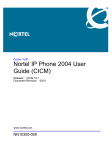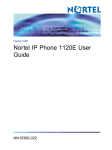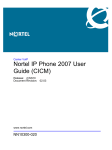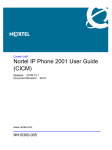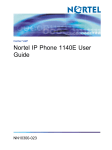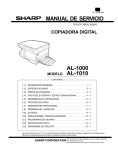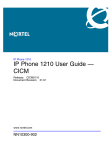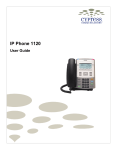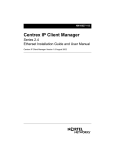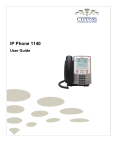Download Cypress 2004 User's Manual
Transcript
IP Phone 2004 with KEM User Guide Document Release: C4 2007_052007 Copyright 2007 Cypress Communications. All rights reserved. Contents Overview 5 Functional components 5 Hardware features 6 IP Phone display 8 Connecting the IP Phone 2004 components Before you begin 9 9 Logging on 11 Logging off 12 Displaying the menu 13 Changing your audio profile 14 Adjusting the display contrast 15 Using the Feature menu 16 Using the Assign menu 16 Defining the key type 16 Assigning a directory entry to a feature key 17 Enabling or disabling autoscroll 18 Enabling or disabling the Inbox 18 Labeling a feature key 19 Using the Options menu 20 Enabling or disabling auto hide 20 Selecting the default line key 20 Enabling the Outbox feature 21 Resetting the feature key to the default settings 22 Selecting a language 22 Using the Time menu 23 Setting the time zone 23 Enabling Daylight Saving Time 23 Disabling Daylight Saving Time 24 4 Contents Setting the time format 24 Setting the date format 25 Resetting the default time 26 Using the User menu 27 Viewing your user name 27 Viewing your login type 27 Viewing, disabling, or enabling the auto login feature 28 Changing your password 29 Testing the local mode 29 Making a call 30 Use off-hook dialing 30 Using handsfree dialing 30 Using Predial 31 Answering and terminating calls 32 Answering a call 32 Terminating a call 32 While on an active call 33 Placing a call on hold 33 Using the mute feature 33 Transferring a call 34 Busy Lamp Field 34 Multiple Appearance Directory Number 34 Using the call park feature 34 While away from your desk 35 Forwarding calls 35 Conference calls 36 Setting up a conference call 36 Using the call join feature 37 Using the Inbox 38 Accessing the Inbox 39 Viewing Inbox call information 39 Storing a number from the Inbox 39 Using the Inbox to make a call 40 Resetting the Inbox 41 Using the Outbox Accessing the Outbo3 42 Viewing Outbox call information 43 Storing a number from the Outbox 43 Using the Outbox to make a call 44 Resetting the Outbox 44 42 Contents 5 Additional features and controls 45 Using the dialpad to enter text 45 Use the Symbol key to enter special characters 45 Procedure job aid 46 Using the directory 46 Adding or editing a directory entry 46 Deleting an entry from the directory 47 Making a call using the directory 48 Volume Control Bar 48 Selecting a ring tone 48 LCD Indicator 48 Message Waiting Lamp 48 IP Phone Key Expansion Module IP Phone Key Expansion Module Overview Key Expansion Module features Key Expansion Module configuration Setup and assembly Key Expansion Module initialization Controls and settings 49 49 50 51 52 52 54 49 Overview Functional components The IP Phone 2004 supports the following functional components: • a handset • a speaker and headset connector for handsfree operation • a standard telephone keypad • call service keys: Release, Hold, volume control, and Mute • a liquid crystal display (LCD) area • navigation keys for scrolling through menu items, the Inbox, the Outbox, and directory lists To use the IP Phone 2004, log on by entering a user name and password. After login, the handset and keypad of the IP Phone operate in the same way as a standard PBX telephone. Additional services and features can be accessed using the softkeys of the function display area. Each of the softkeys corresponds to a menu option ,and the navigation keys can be used to select a particular menu option. "IP Phone 2004" (page 6) shows the functional components of the IP Phone. 5 Overview IP Phone 2004 Hardware features The IP Phone 2004 with KEM supports the following features: • supports the use of two Key Expansion Modules (KEMs) for maximum of 44 programmable keys (plus any additional lines available on the 2004). — six physical user-defined feature keys and six lines/features accessed using the up and down navigation keys to scroll through pages of features — the primary directory number (DN) key (green) always has the PDN displayed against this key • four soft keys for navigation and selection of items in the menu system • multifield liquid crystal display (LCD) display screen; four-line display area • speaker for on-hook dialing or on-hook listening • volume control bar for adjusting ringer, speaker, handset and headset volume • six specialized fixed keys: — Quit — Copy 6 IP Phone display — Directory — Message (Inbox) — Outbox — Services • four call-processing fixed keys: — Hold — Goodbye — Handsfree — Mute • shared LAN access with a PC through the use of the Internet Switch Module; splits the LAN drop into separate feeds for the phone and a PC • adjustable angle stand • headset jack with On/Off key • handsfree microphone • automatic network configuration 7 Overview IP Phone display The IP Phone 2004 display is organized into 4 areas. "IP Phone Display" describes each area. IP Phone 2004 display • Six user-defined feature keys provide additional call features for the IP Phone. • One soft key allows you to select menu items, and to interact with the menu system. • To select a numerically-indexed menu item, select the item on the screen and then press OK, or you can press the shortcut key (press the dialpad key that corresponds to the number of the item). Shortcut keys let you jump directly to the screen without scrolling. • Press the Menu soft key or the Services key on the IP Phone to access the menu system. See "IP Phone 2004" (page 6) for the location of this key. 8 Connecting the IP Phone 2004 components Before you begin CAUTION Damage to Equipment Do not plug the IP Phone into a regular telephone jack. This results in severe damage to the IP Phone 2004. Consult your system administrator to ensure that you plug your telephone into a 10/100BaseT Ethernet jack. See "IP Phone 2004" (page 6) for the location of the connectors. Step Action 1 Connect one end of the handset cord to the handset jack (identified with a handset icon) on the back of the telephone. Connect the other end to the jack on the handset. 2 Choose one of the following connections: • For an IP Phone not sharing LAN access with a PC, connect one end of the CAT5 line cable to the LAN Ethernet port (identified by a LAN icon) located on the back of the phone. Plug the other end of the CAT5 line cable into the IP network. • For an IP Phone sharing LAN access with a PC, connect one end of the CAT5 line cable to the LAN Ethernet port (identified by a LAN icon) located on the back of the phone, and the other end to the IP network. Insert a second CAT5 line cable into the PC Ethernet port located on the back of the phone (identified by a PC icon) and the other end into the computer Ethernet port. 9 14 Connecting the IP Phone 2004 components 3 For a secure power connection, thread the excess cord around the strain relief retaining hook and channel provided. 4 Secure the IP Phone footstand to the base. Use the angle grip on the top back of the phone to adjust the angle of the phone. —End— IP Phone connectors 10 15 Logging on Follow this procedure to log on to the network. If the Centrex IP Client Manager (CICM) is set up as part of a group of CICMs, you can choose which CICM to connect to. After you select a gateway, the terminal directs itself at that CICM and the Username screen appears. Step Action 1 If the Selective Gateway Login feature is configured on your system, navigate through the list to select the gateway. 2 When the gateway you want appears, press Ok, or start entering your username. If the Username screen appears when you start to enter your user name, the characters you already entered appear at the beginning of the Username field. 3 If you make a mistake, press Clear to clear the field, and then enter the username again. If your username is too long for the display (longer than15 characters), the digits scroll to the left and an ellipsis appears to the left of the user name. 4 Press Ok. The Password screen appears. 5 Enter your password. For security, the password characters are displayed as asterisks (*). 6 If you make an error, press Clear to clear the field, and then enter the password again. 7 Press Ok. You are logged on and the Menu screen appears. 11 16 Logging off 19 Logging off Follow this procedure to log off from the network. Step Action 1 From the main menu, select Logoff. 2 Press Ok. A confirmation screen appears. 3 Press Yes. You are logged off from the system. —End— 12 17 Displaying the menu Follow this procedure to access the main menu. You must be logged on to access the main menu system. Step Action 1 On the IP Phone, perform one of these actions: • press the Menu soft key • press the Services key The main menu opens. 2 Perform one of these actions: • Select Logoff • Select Audio • Select Display . See • Select Feature • Select Language • Select Time • Select User • Select History • Select Diagnostics IP Phone 2004 menu hierarchy "Adjusting the display contrast" (page 23). 21 Changing your audio profile Follow this procedure to view and edit your audio profile. Local Area Network is an example of a profile datafilled by your administrator. Use this menu to select the profile you wish to use. Contact your administrator for recommended profiles. Step Action 1 From the main menu, select and open Audio Profile. The Audio Profile screen appears. 2 Press Ok. The Audio Profile screen appears. If you have permission to edit your profile, a check mark appears beside the profile name in the display. 3 If you have permission to edit your profile, you can toggle between enabling and disabling the Audio Local Area Network functionality by pressing the down navigation key. Press Ok to save the setting and return to the Main menu. Press Cancel to return to the Audio Profile screen without saving your changes. —End— 14 23 Adjusting the display contrast Follow this procedure to adjust the contrast level of the display. Step Action 1 From the main menu, select and open Display. The Display menu opens. 2 Press Ok. 3 Perform one of these actions: • To decrease the contrast level, press the soft key on the far left. • To increase the contrast level, press the soft key second from the left. The percentage figure shows the change in the contrast. 4 When you find the contrast you like, press the Ok button to save the change. The current contrast level is saved and you return to the previous screen. —End— 15 Using the Feature menu Follow this procedure to use the Feature menu. You can add or edit feature key associations on your IP Phone 2004. Features are assigned by your system administrator, so the features you have available may differ from those described in this user guide. Changing the keys to which a feature is associated does not create new functionality. Using the Assign menu Follow these procedures to use the Assign menu. Defining the key type Follow this procedure to assign a key type to a feature key. Each feature key can be defined in one of two ways: Central or Local. A feature key defined as Central can have a Centrex feature, such as Call Forward, assigned to it. A feature key defined as Local can have a directory entry assigned to it. By default, all feature keys are defined as Central. Step Action 1 From the main menu, open the Feature menu. A list of the feature keys and their current assignments appears. 2 Select a key to change. The Feature submenu appears. 3 Select and open Assign. If the key you selected in step 2 is assigned to a Centrex feature, these soft key labels appear: Key Type and Autoscroll. If the selected key is assigned to a local feature, these soft key labels appear: Key Type and Feature. 16 26 Using the Feature menu 4 Press Key Type. The Key Type screen appears. A check mark appears beside the type currently assigned to the key. 5 6 Perform one of these actions: • To change Central to Local, select Local. • To change Local to Central, select Central. Press Ok. The key type is changed and a check mark appears beside the selection. 7 To assign a directory entry to a Local key, see "Assigning a directory entry to a feature key" (page 26). Assigning a directory entry to a feature key Follow this procedure to assign a directory entry to a feature key. Assigning a directory entry to a feature key gives you the ability to speed dial that number when you press the key. Prerequisites The feature key you select must be defined as Local, see "Defining the key type" (page 16). Step Action 1 From the main menu, open the Feature menu. A list of the feature keys and their current assignments appears. 2 Select the key defined as Local. The Assign menu appears. 3 Press Feature. The directory contact list opens. 4 Scroll through the list and select the entry to assign to the feature key. 5 Press Ok. A check mark appears beside that entry in the directory. The number is dialed when you press the key. —End— 17 Using the Assign menu 27 Enabling or disabling autoscroll If autoscroll is enabled, the IP Phone automatically directs you to the screen for the active feature. For example, if your secondary Directory Number (DN) is configured on screen two, and you receive a call to that number, the feature screens scroll to page two. You can answer the call immediately without searching for the screen. Follow this procedure to enable or disable the AutoScroll feature. Step Action 1 From the main menu, open the Feature menu. 2 From the Feature menu, select and open Assign. The Assign menus opens. 3 From the Assign menu, select AutoScroll. 4 Press Ok. The AutoScroll screen appears. 5 6 Perform one of these actions: • To enable autoscroll, select Enable. • To disable autoscroll, select Disable. Press Ok. A check mark appears beside the option you selected. You return to the Assign menu. —End— Enabling or disabling the Inbox Follow this procedure to enable or disable the Inbox feature. Step Action 1 From the main menu, open the Feature menu. 2 From the Feature menu, select and Assign. The Assign menu opens. 18 28 Using the Feature menu 3 From the Assign menu, select and open Inbox. The Inbox screen appears. 4 5 Perform one of these actions: • To enable the Inbox, select Enable. • To disable the Inbox, select Disable. Press Ok. A check mark appears beside the option to indicate your choice. You return to the Assign menu. —End— Labeling a feature key Follow this procedure to change the label associated with a feature. If you are unfamiliar with how to use the dialpad to enter text, see "Using the dialpad to enter text" (page 45) before you begin this procedure. Step Action 1 From the main menu, open the Feature menu. 2 From the Feature menu, select and open Label. The Enter Label screen appears. 3 Press Clear to delete the current label. 4 Use the dialpad to enter the new label. 5 To correct the label, press Bkspc. 6 When you have correctly entered the new label, press Ok. The new label is applied. You return to the Feature menu. —End— 19 Using the Options menu 29 Using the Options menu Follow this procedure to open the Options menu. Step Action 1 From the main menu, open the Feature menu. 2 From the Feature menu, select and open Options. 3 Press Ok. The Options menu opens. —End— Enabling or disabling auto hide Follow this procedure to enable or disable auto hide. When you enable the auto hide feature, only those features that are available appear in the display. Feature availability depends on the state of the terminal and the administrator settings. Step Action 1 From the main menu, open the Feature menu. 2 From the Feature menu, select and open Options. The Options menu opens. 3 From the Options menu, select and open Auto Hide. The Auto Hide screen appears. 4 5 Perform one of these actions: • To enable auto hide, select Enable. • To disable auto hide, select Disable. Press Ok. A check mark appears beside your selection. You return to the Options menu. —End— Selecting the default line key Follow this procedure to select a feature key to be your default line key. 20 30 Using the Feature menu Step Action 1 From the main menu, open the Feature menu. 2 From the Feature menu, select and open Options. The Options menu opens. 3 From the Options menu, select and open Default Feature. The Default Feature screen appears, showing a list of DN keys. 4 Scroll through the list to select the key that you want to assign as your default line key. 5 Press Ok. The selected key is now your default line key. You return to the Options menu. —End— Enabling the Outbox feature Follow this procedure to enable the Outbox. Step Action 1 From the main menu, open the Feature menu. 2 From the Feature menu, select and open Options. The Options menu opens. 3 From the Options menu, select and open Outbox. The Outbox screen appears, showing a list of DN keys. 4 Scroll through the list to select the key that you want to assign as your Outbox key. 5 Press Ok. The selected key is now your Outbox key. You return to the Options menu. —End— 21 Resetting the feature key to the default settings 31 Resetting the feature key to the default settings Follow this procedure to reset the feature keys to the default settings. Step Action 1 From the main menu, open the Feature menu. 2 From the Feature menu, select and open Reset. The Reset screen appears. 3 Press Yes. The keys are reset to the default settings. You return to the Feature menu. —End— 33 Selecting a language Follow this procedure to select your language preference. Step Action 1 From the main menu, select and open Language. A list of available languages appears. 2 Scroll through the list and select your preferred language. 3 Press Ok. The terminal now displays text in the selected language. 4 Press Cancel. You return to the main menu. —End— 22 35 Using the Time menu Follow procedures in this section to configure time and date formats. Setting the time zone Follow this procedure to select the time zone. Step Action 1 From the main menu, open the Time menu. 2 From the Time menu, select and open Hours from GMT. The Hours from GMT screen appears. 3 Scroll through the list and select the time zone. 4 Press Ok. The time displayed changes to that of the selected zone. 5 Press Cancel twice to return to the main menu. —End— Enabling Daylight Saving Time Follow this procedure to set Daylight Saving Time. Step Action 1 From the main menu, open the Time menu. 2 From the Time menu, select and open Daylight Saving. The Daylight Saving screen appears. The word Off appears with a check mark beside it to indicate that the feature is disabled. 23 36 Using the Time menu 3 Select On. 4 Press Ok. Daylight Saving Time is enabled. The word On appears with a check mark beside it to indicate the feature is enabled. You return to the previous screen. —End— Disabling Daylight Saving Time Follow this procedure to disable Daylight Saving Time. Step Action 1 From the main menu, open the Time menu. 2 From the Time menu, select and open Daylight Saving. The Daylight Saving screen appears. The word On appears with a check mark beside it, if the feature is enabled. 3 Select Off. Daylight Saving Time is disabled. The word Off appears in the display, with a check mark beside it. You return to the previous screen. —End— Setting the time format Follow this procedure to set the time format the terminal uses to display the current time. The time format choices are: • 12-hour clock • French • 24-hour clock 24 Setting the date format 37 Step Action 1 From the main menu, open the Time menu. 2 From the Time menu, select and open Time Format. The Time Format screen appears. 3 Scroll through the Time Format options to select the format you want. A check mark appears beside the format currently in use. 4 To enable a format, select it, and press Ok. A check mark appears beside the option to indicate that it is enabled. The time is displayed in the selected format. You return to the previous screen. —End— Setting the date format Follow this procedure to set the date format the terminal uses to display the current date. When month (mmm) is selected, the display shows an abbreviated name, Oct for example, and not a number. The date format choices are: • ddmmm • mmmdd • mm/dd • dd/mm Step Action 1 From the main menu, open the Time menu. 2 From the Time menu, select and open Date Format. The Date Format screen appears. 3 Scroll through the Date Format options to select the format you want. A check mark appears beside the format currently in use. 4 To enable a format, select it and press Ok. A check mark appears beside the option to indicate our choice. The date is displayed in the selected format. You return to the previous screen. 25 38 Using the Time menu Resetting the default time Follow this procedure to reset the terminal to the default time. Step Action 1 From the main menu, open the Time menu. 2 Form the Time menu, select and open Reset. A confirmation screen appears. 3 Confirm the action. The terminal reverts to the default time settings. You return to the previous screen. —End— 26 Using the User menu Follow procedures in this section to view and edit your User profile. Viewing your user name Follow this procedure to view your user name. Step Action 1 From the main menu, open the User menu. 2 From the User menu, select and open Username. The Username screen appears, showing your user name. —End— Viewing your login type Follow this procedure to view your login type. The terminal can operate in one of two login types: • Unique—the ability to join a session with an m6350 Softclient is not enabled. • Joint—the ability to operate in a joint session with an m6350 Softclient is enabled. Step Action 1 From the main menu, open the User menu. 2 From the User menu, select and open Login Type. The Unique screen appears. If Unique is enabled, Ok appears above the far left soft key. 3 Press the down navigation key to view the Joint screen. If Joint is enabled, Ok appears above the far left soft key. —End— 27 40 Using the User menu Viewing, disabling, or enabling the auto login feature Follow this procedure to view, enable, or disable the Auto Login feature. Any maintenance activity, for example a firmware upgrade, forces a log off from the network. If you enable auto login, you are automatically logged on to the PC Client when the terminal is available again. Prerequisites You must have permission to edit the auto login feature. If you have permission, a check mark appears next to Enabled when the screen appears. Step Action 1 From the main menu, open the User menu. 2 From the User menu, select and open Auto Login. The Auto Login screen appears displaying your Auto Login profile. If you do not have permission to edit this feature, the procedure is complete. 3 If you have permission to edit this feature, press Ok. The Enabled screen appears. A check mark appears if the feature is enabled. 4 5 Perform one of these actions: • To enable Auto Login, select Enable. • To disable Auto Login, select Disable. Press Ok. A check mark appears beside the item you selected. You return to the Auto Login screen. —End— 28 Changing your password 41 Changing your password Follow this procedure to change your password. If you are unfamiliar with how to use the dialpad to enter text, see "Using the dialpad to enter text" (page 45) before you perform this procedure. Step Action 1 From the main menu, open the User menu. 2 From the User menu, select and open Password. The Old Password screen appears. The system prompts you to enter your old password. 3 Use the dialpad to enter the old password. 4 After you enter the old password, use the dialpad to enter the new password in the same screen. 5 Press Ok. The password is changed and you return to the previous menu. Use the new password the next time you log on. —End— 43 Testing the local mode The Diagnostics menu is mainly used by an administrator for registering the terminal with a Survivable Remote Gateway. Follow this procedure to test the local mode. Step Action 1 From the main menu, open the Diagnostics menu. 2 From the Diagnostics menu, select and open Test Local Mode. A confirmation screen appears. 3 Press Ok. 4 Press Yes. The terminal transitions to its secondary IP address and temporarily disconnects from the PC Client. —End— 29 Making a call There are several ways to make a call from an IP Phone 2004. Use off-hook dialing Follow this procedure to make a call using off-hook dialing. 1 Your primary extension is assigned to the lower right-hand feature key. 2 Pick up the handset and your primary extension is automatically activated and ready for you to make a call. 3 Dial the number. Using handsfree dialing Follow this procedure to make a call using handsfree dialing. 1 To place a call while on Handsfree, press any extension key. 2 Dial the number. 3 When the call is answered, begin speaking. 30 4 For privacy, lift the handset. 5 To return to Handsfree, press the Handsfree key (the small green circular button on the bottom left corner of your telephone) and put the handset down in its cradle. Using Predial Follow this procedure to use the predial feature to make a call. To use Predial: 1 Without selecting the Line (DN) key, enter the number to be dialed. 2 Press the OK option on soft key 1 to dial the number. 3 Lift the handset when the called party answers. To edit a Predial number: 1 Without selecting the Line (DN) key, enter the number to be dialed. 2 Choose one of the following: • To change numbers one-at-a-time, press the Delete soft key to delete characters after the cursor or press the Bkspc key to delete characters before the cursor. Enter a new number. 3 Press the OK option on soft key 1 to dial the number. You can press the OK, Line, Handsfree or Headset key to confirm the predial. 31 Answering and terminating calls Answering a call Each incoming call causes the telephone to sound, the an arrow beside the Line (DN) key to flash, and the Message Indicator lamp to flash. Follow this procedure to answer a call. Choose one of the following to answer a call: • Lift the handset. • Press the Handsfree button located on the left side of the handset. • Press the line (DN) key beside the LCD indicator as it flashes. If a second call comes in, you have the opportunity to put the first caller on hold and answer the second incoming call. • Press the Headset key if a headset is connected to your telephone. Terminating a call Follow this procedure to terminate an active call. Choose one of the following to terminate a call: • Return the handset into the cradle. • Press the Goodbye button located on the left side of the handset. The Goodbye key is especially useful for disconnecting Handsfree calls, dropping out of a Conference Call or exiting Voice Mail. 32 While on an active call This section describes features available during an active call. Placing a call on hold The Hold feature allows you to suspend a call without terminating it. Follow this procedure to use the hold feature. To place a call on hold, press the Hold key. The LCD indicator flashes beside the line on hold. To retrieve a call on hold, press the line (DN) key beside the flashing LCD indicator. Using the mute feature Muting prevents the transmission of sounds through the microphone. Follow this procedure to use the mute feature. 1 A red light next to the green, circular Handsfree button means that your speaker phone is turned on. 2 Press the Mute key located under your volume control bar. 3 A red light appears next to the Mute key, meaning your speaker phone is turned on, but the microphone is off and the caller cannot hear you. 33 52 While on an active call Transferring a call Follow this procedure to transfer a call to another extension. 1 Press the Transfer key in the upper display area. The other party is on hold and a dial tone sounds. The LCD indicator light flashes steadily. 2 Dial the DN to which the call is to be transferred. 3 When that number rings or a person answers, announce the call and then press the Transfer key to connect the calling party. 4 To return to the original call, if the transfer is incomplete, press the line (DN) key (next to the LCD indicator) to reconnect to the original call. If the call is not answered after it is transferred, press the Goodbye key and then press the flashing extension. Busy Lamp Field Busy Lamp Field allows you to monitor on- and off-hook status for any user and to transfer calls efficiently with one-button transfer. Answer the call by lifting the handset or pressing the line key. Then press the Busy Lamp Field Key associated with the user to transfer the call. Multiple Appearance Directory Number (MDN) This feature allows you to answer and place calls for other users such as the CEO of your company. Example: An incoming call for the CEO causes the CEO’s MDN Line to flash. Press the MDN Line to answer. To transfer, press the Transfer key displayed on the LCD of your phone and then the MDN key again. Using the call park feature Use the call park feature to hold temporarily (park) and retrieve a call from any telephone. Using call park does not tie up a line. 1 To park a call to another extension, during an active call, press the Park key in the upper display area. 2 Look at the display. A System Park extension is displayed. Take a note of the number. 3 Press the Park key. 4 Go to any phone and retrieve the call by dialing the System Park number that was displayed. While away from your desk This section describes features to use when you are away from your desk. Forwarding calls Follow this procedure to forward calls to another IP Phone when you are away from your desk. 1 To activate Call Forward, without lifting the handset, press the Forward key in the upper display area. 2 Dial the Extension to which you want your calls to be answered. 3 Press the Forward key. An icon next to the label on the feature key will appear on your display. 4 To deactivate Call Forward, press the Forward key (the icon disappears). To reactivate Call Forward, press the Forward key twice. 35 Conference calls This section describes features that enable conversations between more than two people. Setting up a conference call The conference feature enables you to add up to five people (30 for Multimedia seat) to an established call. Follow this procedure to set up a conference call. 1 While on a call, press the Conference key in the upper display area to place the party on hold. You receive a dial tone. 2 Dial the number of the person you want to add to the conference call. You can talk privately to the person you are adding at this time to announce the conference. 3 Press the Conference key a second time to conference all parties. 4 Repeat the step to include additional people. If you make a mistake dialing, or the party does not want to be included in the conference, press the extension key on which the conference is being held and you will be reconnected to the conference. 36 56 Conference calls Using the call join feature If you are talking with a person and have another person on hold (on another line), you can join both parties into a conference call. 1 While on a call, press the Conference key in the upper display area. 2 Press the extension key that has the number of the person you want to connect to your current call. 3 Press the Conference key to join the person on hold to your conversation. 37 57 Using the Inbox After you assign a feature key to the Inbox, the IP Phone 2004 logs all incoming calls to that key. The system logs the incoming key number, time and date, as well as the display shown on the IP Phone 2004 at the time of the incoming call. The information from the display can be captured only if the call lasts for more than two seconds. If you have assigned an Inbox to a feature key and you miss an incoming call, an envelope icon is displayed in the top left corner of the top screen and a red light-emitting diode (LED) at the top of the set turns on. The icon disappears and the LED turns off when you retrieve the message. Up to four feature keys can be used to monitor the Inbox. View the logged calls by pressing the Inbox key. The Inbox can store a maximum of 10 calls. When the maximum is reached, the oldest call is dropped. Calls appear in the list in the order in which they were received, with the most recent call at the top of the list. Use the up and down navigation keys to scroll through the list. The Inbox call display consists of a time or date stamp, and a name or number. A time stamp appears beside calls you receive on the same day on which you view the Inbox. A date stamp appears beside calls that arrive prior to the day of viewing. If no name or number was extracted from the display, a "No Details" message appears. The display tags the calls in the Inbox with a phone icon to the left of the Inbox screen. The off-hook icon means that you answered the call, whereas the on-hook icon means that you missed the call. 38 58 Using the Inbox Accessing the Inbox Follow this procedure to access and use the Inbox. Step Action 1 Press the Inbox key. The Inbox screen appears, showing a list of the 10 most recent incoming calls. 2 Select an item from the list, and press Ok . 3 Perform one of these actions: • Select Dial to call the number. • Select Display to view call information. • Select Store to store the number in the directory. —End— Viewing Inbox call information Follow this procedure to view the information about a call in the Inbox. Step Action 1 Press the Inbox key. The Inbox screen appears, showing a list of the 10 most recent incoming calls. 2 Select a number from the list. 3 Press Ok. A list of options appears. 4 Select and open Display. The caller information appears. —End— Storing a number from the Inbox Follow this procedure to select a number from the Inbox and save it to the directory. 39 Resetting the Inbox 59 Step Action 1 Press Inbox key. The Inbox screen appears, showing a list of the 10 most recent incoming calls. 2 Select a number from the list. 3 Press Ok. The Dial screen appears. 4 Press the down navigation key to select Store. The directory submenu opens. 5 See "Adding or editing a directory entry" (page 46). —End— Using the Inbox to make a call Follow this procedure to make a call from within the Inbox. Step Action 1 Press the Inbox key. The Inbox screen appears, showing a list of the 10 most recent incoming calls. 2 Select the number you want to dial. 3 Press Ok. 4 Select Dial. 5 Press Ok. The Predial screen appears with the number entered in the display. 6 See "Using Predial" (page 31). —End— 40 60 Using the Inbox Resetting the Inbox Follow this procedure to delete the contents of the Inbox. Step Action 1 From the main menu, select and open History. 2 From the History menu, select Reset Inbox. A confirmation screen appears. 3 Press Yes. The calls in the Inbox are deleted. You return to the previous screen. —End— 41 Using the Outbox After you assign a feature key to the Outbox, the IP Phone 2004 logs all outgoing calls to that DN. The system logs the outgoing key number, time, and date. If the duration of the call is longer than two seconds, the system captures the display as it appeared when the call was made. You can assign only one feature key to the Outbox. The Outbox can store a maximum of 10 calls. When the maximum is reached, the oldest call is dropped. Calls appear in the list in the order in which they were made, with the most recent call at the top of the list. View the logged calls by pressing the Outbox key. The Outbox call display consists of a time or date stamp and a name or number. A time stamp appears beside calls you make on the same day on which you view the Outbox. A date stamp appears beside calls that were made prior to the day of viewing. If no name or number was extracted from the display of the outgoing call, the number dialed appears. Use the navigation keys to scroll through the list. See "IP Phone 2004" (page 10) for the location of the Outbox key. Follow the procedures in this section to use the Outbox feature. Accessing the Outbox Follow this procedure to access and use the Outbox. Step Action 1 Press the Outbox key. The Outbox screen appears, showing a list of the 10 most recent outgoing calls. 2 Select an item from the list, and press Ok. 42 62 Using the Outbox 3 Perform one of these actions: • Select Dial to call the number. • Select Display to view call information. • Select Store to store the number in the directory. —End— Viewing Outbox call information Step Action 1 Press the Outbox key. The Outbox screen appears, showing a list of the 10 most recent outgoing calls. 2 Select a number from the list. 3 Press Ok. A list of options appears. 4 Select and open Display. The caller information appears. —End— Storing a number from the Outbox Follow this procedure to select a number from the Outbox and store it in the directory. Step Action 1 Press the Outbox key. The Outbox screen appears, showing a list of the 10 most recent outgoing calls. 2 Select a number from the list. 43 Resetting the Outbox 63 3 Press Ok. The Dial screen appears. 4 Press the down navigation key to select Store. The directory submenu appears. 5 See "Adding or editing a directory entry" (page 46). —End— Using the Outbox to make a call Follow this procedure to make a call from within the Outbox. Step Action 1 Press the Outbox key. The Outbox screen appears, showing a list of the 10 most recent outgoing calls. 2 Select the number you want to dial. 3 Press Ok. 4 Select Dial. The number is dialed. —End— Resetting the Outbox Follow this procedure to delete the contents of the Outbox. Step Action 1 From the main menu, select and open History. 2 From the History menu, select Reset Outbox. A confirmation screen appears. 3 Press Yes. The calls in the Outbox are deleted. You return to the previous menu. —End— 44 Additional features and controls Using the dialpad to enter text Follow this procedure to use the dialpad to enter text. Use the Symbol key to enter special characters A flashing cursor appears in the display when you can enter text on the screen. Step Action 1 To enter text, find the number key associated with the letter you want to enter, and perform one of these actions: • To enter the first letter, press the key once. • To enter the second letter, press the key twice. • To enter the third letter, press the key three times. The character appears on the display. 2 To enter special characters perform theses actions. See "Special characters" (page 46) for a list of available characters. 3 Press the Symbol soft key. A list of symbols opens. 4 Scroll through the list and select a symbol. 5 Press Ok. —End— 45 66 Additional features and controls Procedure job aid Special characters Using the directory Follow the procedures in this section to use the directory feature. Adding or editing a directory entry Step Action 1 Press the directory key to access the directory. The directory opens. 2 Perform one of these actions: • If this is a new entry, press Ok. • If you are editing an existing entry, navigate through the list to select the entry, then press Ok. The Directory menu opens. 3 From the Directory menu, select and open New Entry. The New Entry menu opens. 4 To add or edit the number, perform these steps: a. From the New Entry menu, select and open Number. b. Use the dialpad to enter the number. c. Press Ok. The number is entered in the directory, and you return to the New Entry menu. 5 To add or edit the surname, perform these steps: a. From the New Entry menu, select and open Surname. b. Use the dialpad to enter the surname. c. Press Ok. The surname is entered in the directory, and you return to the New Entry menu. Using the directory 6 67 To add or edit the first name, perform these steps: a. From the New Entry menu, select and open First Name. b. Use the dialpad to enter the first name. c. Press Ok. The first name is entered in the directory, and you return to the New Entry menu. 7 When you finish entering or editing the information, select Save. You are asked to confirm the action. 8 Perform one of these actions: • To save, press Yes. • To edit the information, press No. The Resume Editing? message appears. Press Yes to edit the information. Press No to exit the directory without saving the information. —End— Deleting an entry from the directory Follow this procedure to delete an entry from the directory. Step Action 1 Press the Directory key. The directory opens. 2 From the directory list, select the entry you want to delete. 3 Press Ok. The Directory menu opens. 4 Press the down navigation key until the Delete option appears. 5 Press Ok. A confirmation screen appears. 6 Press Ok and then press Yes to confirm the action. —End— 68 Additional features and controls Making a call using the directory Follow this procedure to make a call from within the directory. Step Action 1 Press the directory key to access the directory menu. The directory opens. 2 From the Directory list, select the name or number that you want to call. 3 Press Ok. The Dial screen appears. 4 Press Ok The number is dialed. —End— Volume Control Bar Use the Volume Control Bar to adjust the volume of the handset, speaker or ringer while active. Raise or lower the volume of each by pressing the right or left sides of the bar. LCD Indicator A steady indicator means that an extension or feature beside it is active. A flashing indicator means the line is on hold or the feature is in the process of being programmed. Message Waiting Lamp The light bar at the top of your telephone illuminates with a steady light to indicate a new Voice Mail message(s) is waiting. You access Message Waiting by pressing the Message Waiting feature provisioned on one of the feature keys in the upper display area. If you have not provisioned a Message Waiting key, access your Voice Mail by dialing your Voice Mail system. 48 IP Phone Key Expansion Module Overview This document describes the IP Phone Key Expansion Module (KEM) and how to use it with the 2004 IP Phone. IP Phone Key Expansion Module description KEM is a hardware component that connects to an IP Phone to expand the number of keys available to the phone. When KEM is used with the Centrex IP Client Manager (CICM), only 22 keys are available, despite there being 24 physical keys on the KEM. Keys on the KEM are displayed in two columns of 12 keys, with one column on each side of a central liquid crystal display (LCD) screen. When deployed with CICM, the top two keys of each column are not used. When a KEM is installed on an IP Phone, the IP Phone controls the keys of the KEM just as it does its native keys. 49 Overview IP Phone Key Expansion Module Each KEM has a desk-mount bracket and structural base plate to connect the KEM to an IP Phone 2004 or to another KEM. You can connect a maximum of two KEMs to the IP phone 2004. A standalone IP Phone 2004 has 11 feature keys. Adding one KEM increases the number of feature keys to 33. Adding two KEMs increases this number to 44. Key Expansion Module features The IP Phone Key Expansion Module (KEM) has the following features: • 24 keys, arranged in two columns on the outside of an LCD display. These keys provide a maximum of 44 additional, user-labeled feature keys or lines, to the IP phone. • desk-mount bracket and structural base plate to connect the KEM to an IP Phone 2004 or to another KEM • wall-mount bracket to install the KEM alongside a wall-mounted IP Phone 2004 50 Key Expansion Module display Key Expansion Module configuration The IP Phone Key Expansion Module (KEM) does not have an option menu of its own. When a KEM is installed on an IP Phone, the IP Phone controls the keys of the KEM just as it does its native keys. You can use the IP Phone option menu to configure these KEM options: • language • screen contrast level • display diagnostics • feature key label The only KEM-specific option available from the Centrex IP Client Manager terminal setting menu is Display. Use this option to adjust the brightness of the display. Each of the physical keys on the KEM can have a user-defined label (with a maximum of 10 characters) associated with it. Labels for KEM keys are created using the controls on the IP Phone. KEM keys are numbered sequentially, beginning with the first number after the last defined key on the IP phone. Centrex IP Client Manager supports different contrast settings for each display. This means that you can adjust the contrast level for the display screen on the IP Phone, and each KEM independently. 51 Setup and assembly The IP Phone Key Expansion Module (KEM) mounts on the right side of the IP Phone. A desk-mount bracket and a structural baseplate are provided, to secure the KEM to the IP Phone. KEM attaches to the IP Phone or another KEM through the accessory expansion module (AEM) interface. Extending from the left side of the KEM is a 10-pin female header on a ribbon cable that is connected to inside of the module. Use this ribbon cable to: • connect the ribbon cable to the AEM connector on the right side of the IP Phone. • connect the ribbon cable to the 10-pin recessed male connector on a KEM that is connected to the IP Phone. Installing a Key Expansion Module The following procedure outlines how to connect an IP Phone Key Expansion Module (KEM) to an IP Phone. Step Action 1 Remove the IP Phone from the stand by pressing the tilt handle and pulling the phone away from the stand. Instead of removing an IP Phone 2004 from the stand, you can adjust the angle of the stand to maximum. 2 Place the IP Phone and the KEM face down on a nonabrasive surface and align them. 3 Move the connecting arm of the KEM into the IP Phone and align the connection plug to the accessory expansion module (AEM) port on the back of the IP Phone. 52 Setup and assembly 4 After the cable is attached to the phone, reconnect the ribbon cable to the KEM. The KEM starts when it is attached to a power source. The KEM does not have its own power source, and it draws its power from the IP Phone to which it is connected. 5 Wrap the clamp around the cable and screw the clamp into the back of the IP Phone using a 3 mm and an 8 mm screw. 6 Thread the cable through the opening in the side of the IP Phone. 7 Insert the clips on the IP Phone into the hinges on the footstand and then press onto the front of the footstand until it snaps into place. 8 While squeezing the IP Phone tilt handle, swing the footstand into position. 9 Insert the clips on the KEM into the hinges on the module footstand, and while squeezing the tilt handle on the module, swing the footstand into the desired position. —End— Using the wall-mount option The IP Phone and IP Phone Key Expansion Module (KEM) combination can be wall-mounted using the optional bracket kit provided. A second KEM can be attached to the right side of the first KEM. Adjusting the tilt base The IP Phone 2004 has an adjustable tilt base. Adjust the tilt of both the IP Phone 2004 and the KEM, as needed. 53 Key Expansion Module initialization The IP Phone Key Expansion Module (KEM) starts and begins initialization after it is connected to an IP Phone. In some circumstances on the Centrex IP Client Manager platform, it may be necessary for the user to log off and log on again after attaching the KEM to the IP Phone, before the KEM becomes operational. KEM initialization process Phase Description KEM performs self-test The self-test confirms the operation of the module’s local memory, CPU, and other circuitry. During the self-test, the module display lights up. If the display does not light up, or lights up and then goes blank, or fails to begin flashing, contact your system administrator. KEM establishes communication with the base IP phone The KEM display flashes until it establishes communication with the IP phone. KEM downloads key maps KEM uses key maps to download feature key assignments. Key maps are downloaded after communication is established with the IP Phone. The KEM screen is blank until the key maps are downloaded. Labels appear beside the keys on the module After the three initialization phases are complete, labels appear beside the keys on the KEM. Keys assignments are made by the administrator. If the display does not stop flashing, communication cannot be established with the IP Phone. Contact your system administrator. After the initialization sequence is complete, you can begin to use the additional feature and line (DN) keys that are available through the KEM. If two modules are connected to the IP Phone, the first one in the series must be functioning in order for the second module to operate. This is because the second module depends on the first module to provide power from, and communication with, the IP Phone. 54






















































